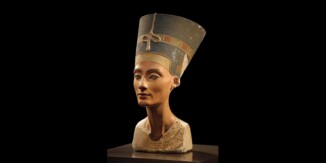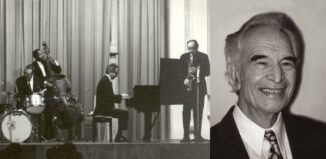And, 60 years ago today, Rudolf the Red-Nosed Reindeer, the animated stop-motion Christmas special, was first broadcast on CBS television. The beloved Rankin/Bass production chronicles the bullying endured by Rudolph (at reindeer school) and a misfit elf named Hermey, who wants to be a dentist. WATCH the No.1 broadcast TV holiday tradition below… (1964)

They run away from home—but head towards trouble. The show introduced many endearing Christmas characters and iconic songs to the holiday lexicon, like Silver and Gold, and Have a Holly Jolly Christmas. Filmed entirely in Japan, the show’s original characters include Rudolph’s love interest, Clarice; the antagonistic Abominable Snowman; a loud, boisterous prospector named Yukon Cornelius; and, as narrator, the anthropomorphic Sam the Snowman, voiced by the wonderful Burl Ives.
MORE Good News on this Date:
- The 13th Amendment to the U.S. Constitution was signed, which formally abolished slavery in the nation (1865)
- The Washington Post newspaper was first published (1877)
- The aluminum capstone, the largest single piece of aluminum cast at that time, was set atop the Washington Monument, the world’s tallest stone structure, to officially complete the memorial obelisk in Washington D.C. (1884)
- Finland declared its independence from Russia (1917)
- A US judge ruled James Joyce‘s novel, Ulysses, was not obscene (1933)
- Led Zeppelin made their debut on the US singles chart with Whole Lotta Love, which eventually reached No.4 and was the first of six Top 40 singles for the group in the US (1969)
- A group of 10th-graders from Israel arrived in New York to help in the ongoing clean-up efforts after Hurricane Sandy (2012)
112 years ago today, the bust of Nefertiti was discovered in the workshop of the sculptor Thutmose’s workshop by German archaeologists. It has become one of the most widely-reproduced images of ancient Egypt, and the woman depicted an icon of feminine beauty. She may have been co-ruler along with her husband Akhenaten, but she was at least the chief consort.

“With this elegant bust, Thutmose may have been alluding to a heavy flower on its slender sleek stalk by exaggerating the weight of the crowned head and the length of the almost serpentine neck,” reads the Gardner’s Art Through the Ages textbook.
Her left eye in the bust is bare limestone with a slot for a quartz stone that was missing when the archaeologists found it, leading to some ideas that she had an ophthalmologic infection. It was thought to be such a pity that the archaeologists, believing that it had fallen out when Thutmose’s workshop fell into disarray, placed a reward for its discovery worth one thousand Deutchmarks.
Various Egyptian governments have requested the artifact’s repatriation, which has become a symbol of the Berlin Museums, perhaps unfairly, as the statue was smuggled out of Egypt in a clay cast. (1912)
490 years ago today, Quito, Ecuador was founded by Sebastian de Belalcazar. Inhabited by indigenous peoples for millennia previously, Quito was one of the two co-announced first World Heritage Sites by UNESCO, and today remains one of the most prestigious cities in Latin America. It’s very unique geographically speaking as well. Sitting just 1 kilometer from the Equator, it’s also the second-highest capital city by elevation, and headquarters of the Union of South American Nations.

Before the Inca conquered the area, the modern-day site of Quito was ruled by a people known as the Quitu. Recently, spectacular stone burial shafts 20 feet deep found in the La Florida neighborhood of Quito were dated to the period that the legend of the Quitu People’s arrival in the city is set—around 800 CE.
Modern Quito is home to more than 2 million people, Quito has the largest, least-altered, and best-preserved historic center in the Americas. This center was, together with the historic center of Kraków, Poland, the first to be declared a World Heritage Site by UNESCO on 18 September 1978.
The historic center of Quito is to the south of the capital’s current center, on an area of 320 ha (790 acres), and one of the most important historic areas in Latin America. There are about 130 monumental buildings and 5,000 properties registered in the municipal inventory of heritage properties.
Surrounding the city are dozens of volcanoes and wildlife sanctuaries. As Ecuador is one of the most biodiverse countries by size on Earth, many of these are frequented by ecologists and biologists looking to protect, discover, or rediscover, various species of birds, reptiles, amphibians, insects, and plants. (1534)
104 years ago today, the American jazz pianist Dave Brubeck, whose Dave Brubeck Quartet produced the first million-selling jazz single, Take Five, was born.

The album Time Out became one of the best-selling jazz LPs of all time after it hit No.2 on Billboard’s pop chart and sold over two million copies. Paul Desmond was the group’s sax player and he wrote the catchy main melody for Take Five over Brubeck’s enticing piano vamps. Desmond donated all his profits from this mega hit to the Red Cross.
WATCH them perform the song, and see how Brubeck changed jazz… (1920)
The pianist and composer died in 2012 one day before his 92nd birthday.
Learn more:

On this day 77 years ago, the Everglades National Park in Florida was dedicated—the first U.S. national park created to protect a fragile ecosystem. Visited by one million people each year, it is the third-largest US national park outside Alaska. The “River of Grass” wetlands cover 2,357 square miles (6,100 sq km) and contain the largest mangrove habitat in the western hemisphere. In 2000, the US Congress voted overwhelmingly to approve a $7.8 billion project to restore the Florida Everglades and undo a half-century of human impact. Rep. Clay Shaw, R-Florida, called the plan “the biggest environmental restoration project in the history of the world.” (1947)
Also, Happy Birthday to Nick Park, the 4-time Oscar award-winning animator who turns 66 today. The English writer and director is best known for his claymation creations of Wallace and Gromit, and Shaun the Sheep—and his 2000 film Chicken Run became the highest-grossing stop-motion animated film ever.

Nick began filmmaking at age 13 with his mother’s home movie camera—and, like his father, he became an amateur inventor.
The amazing characters of Wallace and his dog Gromit, often use their wild inventions to take them on equally wild adventures. Three of their films won Academy Awards and belong on anyone’s ‘must see’ list: The Wrong Trousers (1993), A Close Shave (1995) and Wallace & Gromit: The Curse of the Were-Rabbit (2005). The tantalizing short film Creature Comforts won Nick his first Oscar, after he lip-synced the voices of English people over interviews with claymation zoo animals complaining about not having enough open spaces and sunshine in the UK. WATCH that 5-minute masterpiece below…
Park’s recent work includes an American version of Creature Comforts, and a weekly CBS television series in which Americans were interviewed about a range of subjects, then lip-synced to his iconic animal characters. For 2018, he directed a similar stop-motion film, titled Early Man, which tells a story of a caveman who unites his tribe against the Bronze Age while unintentionally inventing football. (1958)
SHARE the Memories, Milestones, Music, and Movies…





















[…] post Good News in History, December 6 appeared first on The Good News […]
[…] By Good News Network […]